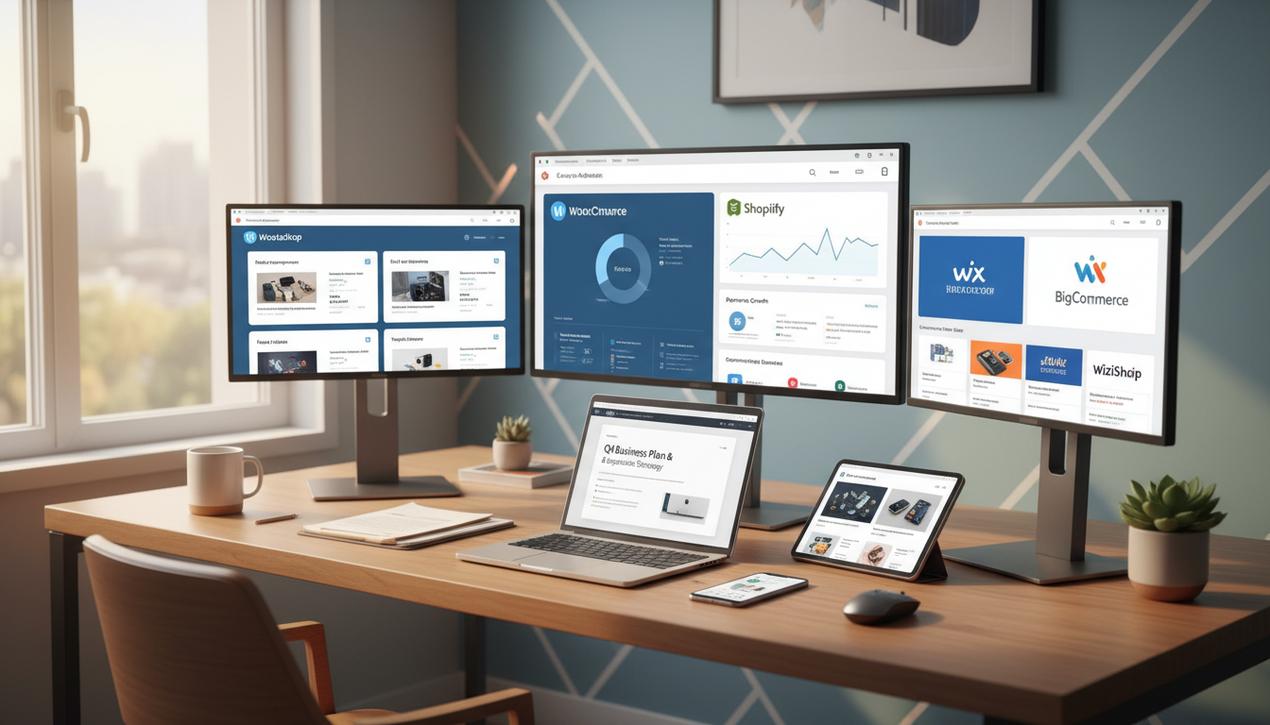A Complete Guide to the Best Ecommerce CMS in 2025


Launching an online store in 2025 is an ambitious venture in a global sector worth trillions of dollars and showing no signs of slowing down. The ecommerce market is projected to grow by over 10% this year alone. At the heart of every successful online business lies a critical technological decision: the choice of an ecommerce CMS. This platform is the digital backbone of your online store, dictating not only its appearance and user experience but also its performance, scalability, and the ease of your day-to-day operations. With a vast array of options available, from open-source giants like WooCommerce, which powers over a quarter of all online stores, to all-in-one SaaS platforms like Shopify, the choice can be overwhelming. The goal is not to find the single “best” CMS, but the one that perfectly aligns with your specific needs, technical skills, and growth ambitions. This guide will illuminate the essential criteria for making your choice and provide a detailed analysis of the 8 leading platforms on the market today.
Key Criteria for Choosing Your Ecommerce CMS
Before you start comparing platforms, it’s crucial to define your requirements in a clear brief. Your final decision will depend directly on the answers to the following questions. This initial planning will save you from costly and complex migrations in the future.
1. The Size and Complexity of Your Catalog
The number of products you plan to sell is a primary factor. A boutique store with a dozen unique items has vastly different needs than an online retailer with thousands of products and multiple variations like sizes, colors, and materials. Some ecommerce CMS platforms are optimized for smaller catalogs and straightforward management, while others, like Magento, are engineered to handle massive, complex inventories with exceptional granularity.
2. Your Technical Skills and Human Resources
Will you be managing the store alone, or as part of a team? Do you have in-house web development skills, or do you prefer a turnkey solution? SaaS (Software as a Service) platforms like Shopify and Wix offer incredible ease of use with intuitive drag-and-drop interfaces, making them ideal for beginners. Conversely, open-source CMS platforms like PrestaShop or WooCommerce provide nearly limitless flexibility but require more robust technical skills for customization, security, and ongoing maintenance.
3. The Ecosystem and Necessary Integrations
Your ecommerce site will not operate in a vacuum. It must seamlessly connect with your other business tools: your CRM, email marketing solution, ERP for inventory management, and the best accounting software. Before committing, verify the availability and quality of APIs or plugins for each CMS. A rich app marketplace and an active developer community are strong indicators that your store will be able to evolve as your business needs grow.
4. Scalability and Long-Term Performance
What are your goals in 3, 5, or 10 years? If you anticipate significant growth, choosing a CMS capable of handling high traffic volumes and a large number of concurrent transactions is vital. Headless commerce, a major trend in 2025, decouples the back-end (management) from the front-end (the customer-facing storefront). This architecture offers unparalleled flexibility, performance, and the ability to deliver content to any device or platform, making it a key consideration for ambitious projects.
Our Comparison of the 8 Best Ecommerce Platforms in 2025
Once you’ve outlined your needs, it’s time to compare the solutions. Here is our selection of the most popular and powerful platforms, each with its unique strengths and weaknesses.
1. WooCommerce: The Undisputed Leader on WordPress
WooCommerce is not a standalone CMS but a plugin that transforms the world’s most popular CMS, WordPress, into a powerful and flexible online store. It dominates the global market thanks to its adaptability and massive user base.
- Pros: Completely free and open-source, easy to learn for existing WordPress users, thousands of themes and extensions for limitless customization, excellent native SEO capabilities.
- Cons: You are fully responsible for security and maintenance, can become slow with too many plugins, no dedicated technical support (relies on community forums).
- Best for: Entrepreneurs and SMBs who are already familiar with WordPress and are looking for a flexible, cost-effective solution.
2. Shopify: The Gold Standard for Simplicity
Shopify is the leading SaaS ecommerce platform, renowned for allowing anyone to launch a store quickly without worrying about hosting or technical maintenance.
- Pros: Extremely user-friendly, includes hosting and top-tier security, highly responsive 24/7 customer support, a wide array of professional themes, and a massive app ecosystem.
- Cons: Less customization flexibility than open-source, transaction fees apply on every sale unless you use Shopify Payments, and monthly costs can rise with paid apps.
- Best for: Beginners, dropshippers, and businesses that want to focus entirely on selling and marketing rather than the technical aspects of running a site.
3. PrestaShop: The Powerful French Open-Source Solution
PrestaShop is a feature-rich, open-source solution built from the ground up for ecommerce. It’s a robust alternative to WooCommerce, particularly popular in Europe.
- Pros: Very powerful for managing large product catalogs, advanced native features (inventory, logistics, multi-currency), a large and active European community, and numerous available modules.
- Cons: A steeper learning curve than Shopify, many essential themes and modules are paid, and no centralized technical support.
- Best for: SMBs and larger companies with complex ecommerce needs and access to technical resources (in-house or freelance).
4. Magento (Adobe Commerce): The Behemoth for Enterprise
Now part of the Adobe family, Magento is the CMS of choice for large enterprises with complex operations and international ambitions. It is arguably the most robust ecommerce solution on the market.
- Pros: Can handle tens of thousands of products and multiple storefronts from a single dashboard, infinite customization possibilities, highly performant and secure.
- Cons: Extremely complex to manage, requires specialized developers and powerful dedicated hosting, and involves high development and maintenance costs.
- Best for: Major national and international brands like Nike and Coca-Cola that have significant budgets and require enterprise-grade features.
*
5. Wix: The Website Builder with Growing Ecommerce Power
Initially known as a simple website builder, Wix has significantly expanded its ecommerce capabilities. It now stands as a direct competitor to Shopify for beginners and small businesses.
- Pros: Highly intuitive drag-and-drop interface, over 500 modern templates, hosting included, good integrated marketing features (email, social ads).
- Cons: Can suffer from slower loading times, as a proprietary solution it limits advanced customization, and the free version includes ads.
- Best for: Small businesses, artisans, and creators who want a beautiful storefront with simple sales functionality.
6. BigCommerce: The Scalable SaaS Alternative
BigCommerce is a powerful SaaS platform that stands out with its headless-first approach and, crucially, its policy of zero transaction fees on all its standard plans.
- Pros: No transaction fees, advanced native SEO features, excellent multi-channel management (Amazon, eBay, Google Shopping), and a flexible architecture built for headless commerce.
- Cons: Fewer free themes available than Shopify, a slightly steeper learning curve, and a smaller app marketplace.
- Best for: Growing businesses looking for a Shopify alternative with more built-in features and no transaction fees.
7. Squarespace: Where Design Comes First
Squarespace is celebrated for its elegant and minimalist designs. It is the go-to platform for brands where aesthetics and brand image are paramount.
- Pros: Stunning and highly professional templates, excellent user experience, very easy to use, and an all-in-one package with hosting included.
- Cons: Fewer payment gateway options than its competitors, a more limited app ecosystem, and less flexibility for highly specific ecommerce needs.
- Best for: Creatives, photographers, designers, and luxury brands that sell a limited range of products and prioritize visual presentation.
8. WiziShop: The All-Inclusive European Challenger
WiziShop is a French SaaS solution that focuses on simplicity and comprehensive user support. It natively integrates a wide range of marketing and SEO features.
- Pros: Very easy to get started, includes full video training, over 400 native features at no extra cost, and advanced SEO optimizations built-in.
- Cons: Less graphic customization than other platforms, can be limiting for very large catalogs, and includes transaction fees on sales.
- Best for: Beginners and SMBs in Europe looking for an all-in-one solution with strong guidance and support.
Choosing an ecommerce CMS is a strategic decision that will have a long-lasting impact on your business. There is no one-size-fits-all solution. Take the time to evaluate your current and future needs, your available resources, and the unique characteristics of each platform. SaaS solutions like Shopify or Wix are perfect for getting started quickly with minimal technical hurdles, while open-source platforms like WooCommerce or PrestaShop offer unparalleled freedom and scalability for those with the skills or partners to leverage them. In 2025, the success of your online store will depend as much on the quality of your products as on the strength of the technological foundation it is built upon.



